Themed collection Coordination Programming: Science of Molecular Superstructures Towards Chemical Devices

Front cover
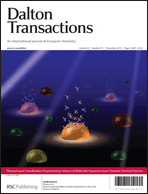
Inside front cover
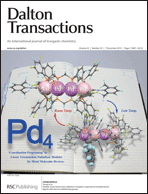
Back cover
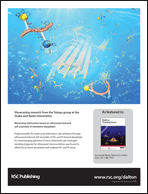
Coordination programming: science of molecular superstructures towards chemical devices
Welcome to this themed issue of Dalton Transactions entitled “Coordination Programming: Science of Molecular Superstructures Towards Chemical Devices”.

Dalton Trans., 2013,42, 15825-15825
https://doi.org/10.1039/C3DT90157B
Long-lived photoinduced charge separation for solar cell applications in supramolecular complexes of multi-metalloporphyrins and fullerenes
We review photoinduced charge separation in surpramolecular complexes of porphyrins and fullerenes, towards construction of suparamolecular solar cells based on the long-lived photoinduced charge separation.

Dalton Trans., 2013,42, 15846-15858
https://doi.org/10.1039/C3DT51883C
Fluorescent azobenzenes and aromatic aldimines featuring an N–B interaction
The N–B interaction makes azobenzenes and aromatic aldimines fluorescent, and their properties change in response to protons, electrons, and ions.

Dalton Trans., 2013,42, 15826-15834
https://doi.org/10.1039/C3DT51689J
Sequential growth at the sub-10 nm scale of cyanide bridged coordination networks on inorganic surfaces
The elaboration of coordination networks’ nano-objects on surfaces can be realized by sequential growth in solution (SGS).
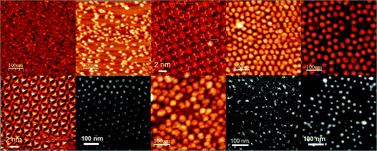
Dalton Trans., 2013,42, 15835-15845
https://doi.org/10.1039/C3DT51636A
Bottom-up assembly of ultrathin sub-micron size metal–organic framework sheets
Highly-crystalline ultrathin metal–organic framework nanosheets with sub-micron planar size were created by a solution-based two-dimensional interfacial reaction.
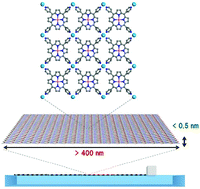
Dalton Trans., 2013,42, 15931-15936
https://doi.org/10.1039/C3DT51703A
Oxo-carboxylato-molybdenum(VI) complexes possessing dithiolene ligands related to the active site of type II DMSOR family molybdoenzymes
Oxo-carboxylato-molybdenum(VI) complexes are generated as models of the active site of type II DMSOR family of molybdoenzymes.
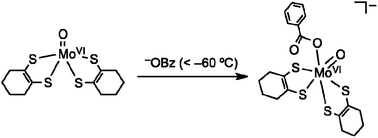
Dalton Trans., 2013,42, 15927-15930
https://doi.org/10.1039/C3DT51485D
Cross-linked conjugated polymer assemblies at the air–water interface through supramoleculer bundling
Cross-linked conjugated polymer assemblies by host–guest interaction were developed at the air–water interface by means of the Langmuir–Blodgett technique.
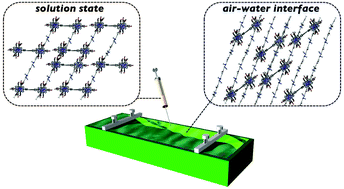
Dalton Trans., 2013,42, 15911-15914
https://doi.org/10.1039/C3DT51468D
A facile and versatile approach to efficient enhancement of solid-state luminescence by organic–inorganic hybrid salts
Organic–inorganic hybrid salts were one of the effective approaches to overcome aggregation-induced quenching in the crystalline state.
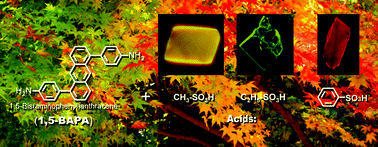
Dalton Trans., 2013,42, 15922-15926
https://doi.org/10.1039/C3DT51422F
Palladium - or proton -induced submicro spherical aggregation of macrocyclic amphiphiles in aqueous solution
Hexaaza-cyclophane ligands which are protonated and palladated with [Pd(en)]2+ form submicrometre-sized spherical aggregates in water.
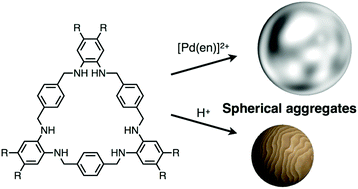
Dalton Trans., 2013,42, 15915-15918
https://doi.org/10.1039/C3DT51827B
A highly-active and poison -tolerant Pt12 sub-nanocluster catalyst for the reductive amination of aldehydes with amines
A Pt12 sub-nanocluster catalyst supported by graphitized mesoporous carbon has been prepared, exhibiting a remarkable catalytic activity in reductive amination. In addition, we revealed that the catalysts have a remarkable poison-tolerance.
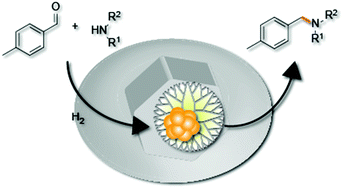
Dalton Trans., 2013,42, 15919-15921
https://doi.org/10.1039/C3DT52099D
Relative anion binding affinity in a series of interpenetrated coordination cages
The affinity of four interpenetrated cages for the binding of chloride and bromide in their outer two pockets is compared experimentally and supported by theoretical methods.
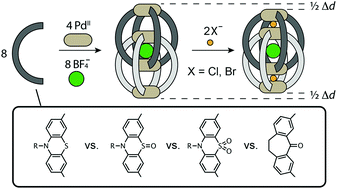
Dalton Trans., 2013,42, 15906-15910
https://doi.org/10.1039/C3DT51709H
Spontaneous electrodeposition of gold and platinum complexes through a coronene adlayer on Au(111)
Spontaneous electrodeposition of AuBr4− and PtBr42− occurred at the coronene adlayer formed on the reconstructed Au(111) surface.
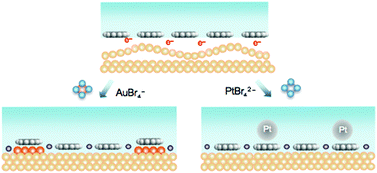
Dalton Trans., 2013,42, 15902-15905
https://doi.org/10.1039/C3DT51443A
Modification of charge transfer in a two-dimensional donor/acceptor framework by the insertion of another donor-type molecule into electronegative interlayer pockets
Pyrene-intercalated layered compounds, [{Ru2(O2CCF3)4}2(TCNQRx)]·2(pyrene) (TCNQRx = 7,7,8,8-tetracyano-p-quinodimethane derivatives; Rx = H4 and F4), were synthesized.
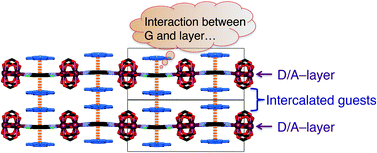
Dalton Trans., 2013,42, 15898-15901
https://doi.org/10.1039/C3DT51271A
Guest responsivity of a two-dimensional coordination polymer incorporating a cholesterol-based co-ligand
A new two-dimensional Hofmann-type coordination polymer incorporating a hydrophobic cholesterol-based co-ligand showed a unique guest response.
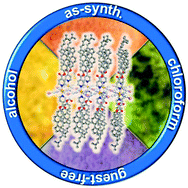
Dalton Trans., 2013,42, 15893-15897
https://doi.org/10.1039/C3DT51465J
Ternary metal Prussian blue analogue nanoparticles as cathode materials for Li-ion batteries
A ternary metal Prussian blue analogue was applied as cathode material for Li-ion batteries. Heterometal substitution led to both a longer cycle life and a higher rate capability.
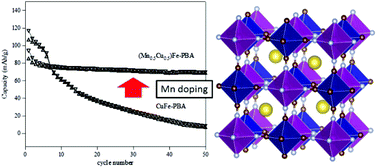
Dalton Trans., 2013,42, 15881-15884
https://doi.org/10.1039/C3DT51369F
Human serum albumin mutants complexed Mn(III) protoporphyrin IX as superoxide dismutase mimics
Genetically engineered human serum albumin mutants complexed Mn(III) protoporphyrin IX in the haem pocket (subdomain IB) showed superoxide dismutase activity.
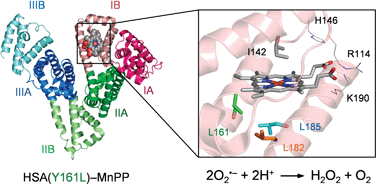
Dalton Trans., 2013,42, 15889-15892
https://doi.org/10.1039/C3DT51418H
Assembled structures of dipyrrins and their oligomers bridged by dioxy-boron moieties
A linear arrangement of BODIPY dimers and trimers was transformed into boron-bridged box, ladder and cage structures on treatment with spacer units possessing multiple diol moieties.

Dalton Trans., 2013,42, 15885-15888
https://doi.org/10.1039/C3DT50783A
Synthesis of a hetero-dinuclear metal complex in a porphyrin /phthalocyanine four-fold rotaxane
A hetero-dinuclear metal complex consisted of cofacially stacked Cu2+–porphyrin and Zn2+–phthalocyanine connected by four rotaxanes.
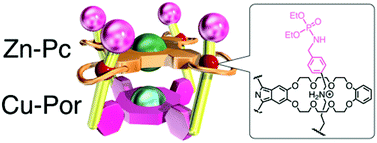
Dalton Trans., 2013,42, 15873-15876
https://doi.org/10.1039/C3DT51043C
A bis(terpyridine)iron network polymer on carbon for a potential energy storage material
A bis(terpyridine)iron network polymer modified glassy carbon electrode possessing superior electrochemical properties has high potential for energy storage applications.
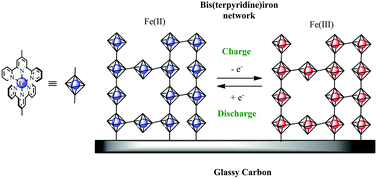
Dalton Trans., 2013,42, 15877-15880
https://doi.org/10.1039/C3DT51186C
Programmed crystallization via epitaxial growth and ligand replacement towards hybridizing porous coordination polymer crystals
Hybridized porous coordination polymers with sandwich or core–shell configuration are synthesized either through epitaxial growth or ligand replacement, respectively.
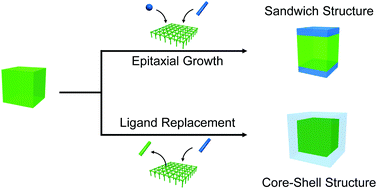
Dalton Trans., 2013,42, 15868-15872
https://doi.org/10.1039/C3DT50679G
A nanospherical polymer as an MRI sensor without paramagnetic or superparamagnetic species
A pH-responsive nanospherical polymer works as a metal-free magnetic resonance imaging sensor for pH.
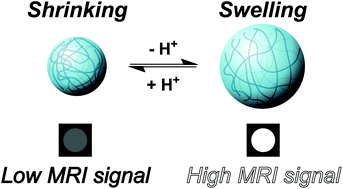
Dalton Trans., 2013,42, 15864-15867
https://doi.org/10.1039/C3DT50378J
Amphiphilic ferrocenylated alkylpyridinium: the formation of micelles and hydrogels and their disaggregation induced by an external stimulus
Ferrocene-containing amphiphiles [py-N-(CH2)nOCH2Fc]Cl (n = 6, 8, 10; py = C5H5N, Fc = Fe(C5H4)(C5H5)) in aqueous media form micelles which are changed to a solution, pseudorotaxanes with α-cyclodextrin, and their hydrogels upon an outer stimulus.
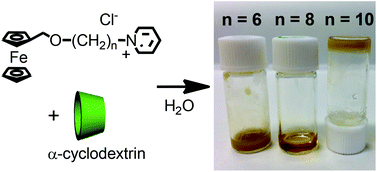
Dalton Trans., 2013,42, 16222-16230
https://doi.org/10.1039/C3DT51597D
Triple-stranded ferric helices: a π–π interaction-driven structural hierarchy of Fe5, Fe7, and Fe17 clusters
Polypyridyl ligands were used to support triple-stranded helical [Fe5], [Fe7] and [Fe17] complexes. The redox-active complexes were stabilized by increasing degrees of π–π stacking between the ligand moieties.
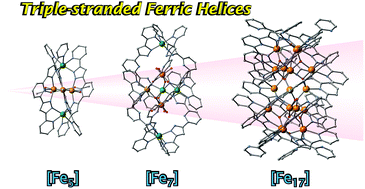
Dalton Trans., 2013,42, 16185-16193
https://doi.org/10.1039/C3DT51480C
Trilayer-cubic core–shell structure of PbS/EuS nanocrystals revealed by the combination of the synchrotron small-angle X-ray scattering method and energy-dispersive X-ray spectroscopy
Detailed information on a PbS/EuS/Eu2O3 hetero-nanostructure was obtained by combining SAXS and EDS-TEM data analyses.

Dalton Trans., 2013,42, 16216-16221
https://doi.org/10.1039/C3DT51710A
Highly selective sorption and unique packing geometries of unsaturated hydrocarbons and CO2 in a fluorine-substituted organic–inorganic ionic crystal
Highly selective sorption and unique packing geometries of acetylene and CO2 were observed in a fluorine-substituted organic–inorganic ionic crystal.
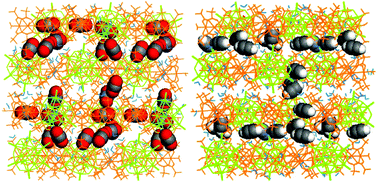
Dalton Trans., 2013,42, 16209-16215
https://doi.org/10.1039/C3DT51458G
A redox-active porous coordination network film based on a Ru complex as a building block on an ITO electrode
The permselectivity of a porous coordination network film containing a novel Ru complex with 2,6-bis(N-pyridylbenzimidazolyl)-pyridine ligands as a building block was studied by cyclic voltammetry and EQCM measurements.
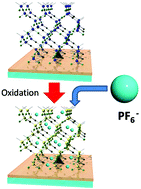
Dalton Trans., 2013,42, 16166-16175
https://doi.org/10.1039/C3DT51484F
Theoretical studies of electronic structures, magnetic properties and electron conductivities of one-dimensional Nin (n = 3, 5, 7) complexes
Electronic structures, magnetic properties and electron conductivities of one-dimensional Ni complexes were investigated by DFT calculations.
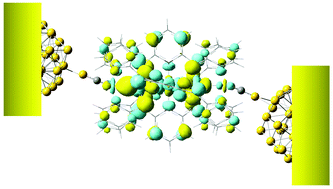
Dalton Trans., 2013,42, 16200-16208
https://doi.org/10.1039/C3DT51466H
Phosphorescent properties of metal-free diphosphine ligands and effects of copper binding
We studied the luminescence properties of copper(I) complexes containing bis[2-(diphenylphosphino)phenyl]ether (DPEphos), [Cu(DPEphos)(CH3CN)]PF6 (1), [Cu(DPEphos)2]PF6 (2), and copper(I) complexes with 4,5-bis(diphenylphosphino)-9,9-dimethylxanthene (xantphos), [Cu(xantphos)(CH3CN)2]PF6 (3), [Cu(xantphos)2]PF6 (4) in the solid state.
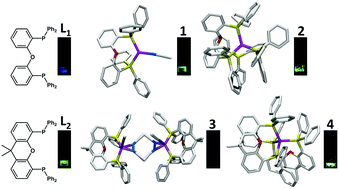
Dalton Trans., 2013,42, 16096-16101
https://doi.org/10.1039/C3DT51390D
Hydrothermal synthesis of inorganic–organic hybrid gadolinium hydroxide nanoclusters with controlled size and morphology
Inorganic–organic hybrid Gd(OH)3 nanoclusters were synthesized by using 3,4-dihydroxyhydrocinnamic acid (DHCA) which are composed of small nanoparticles interlinked by DHCA molecules and show paramagnetic behavior.
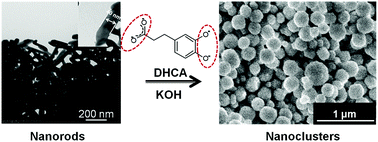
Dalton Trans., 2013,42, 16176-16184
https://doi.org/10.1039/C3DT51692J
A distorted honeycomb motif in divalent transition metal compounds based on 4-phosphonbenzoic acid and exchange coupled Co(II) and Cu(II): synthesis, structural description and magnetic properties
The first divalent open shell cobalt phosphonate compound based on a honeycomb motif is presented. The magnetic properties are reported together with those of the corresponding copper compound.
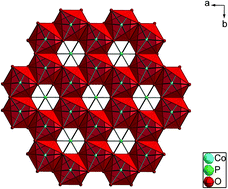
Dalton Trans., 2013,42, 16194-16199
https://doi.org/10.1039/C3DT51437D
Synthesis and nanostructures of several tetrathiafulvalene derivatives having the side chains composed of chiral and hydrogen-bonding groups and their charge-transfer complexes
Tetrathiafulvalene (TTF) derivatives TTF-Bor, TTF-2UM and TTF-4UM having chiral urethane groups were prepared.
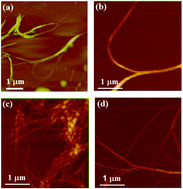
Dalton Trans., 2013,42, 16121-16127
https://doi.org/10.1039/C3DT51464A
Zinc-porphyrins functionalized with redox-active metal peripherals: enhancement of dπ–pπ interaction leading to unique assembly and redox-triggered remote switching of fluorescence
Coupling of the redox-active Fe and Ru fragments with the Zn-porphyrin leads to the unique systems such as redox-triggered switching of fluorescence and supramolecular interaction with guest molecules.
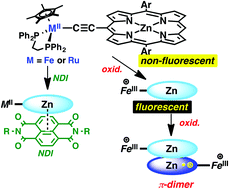
Dalton Trans., 2013,42, 16108-16120
https://doi.org/10.1039/C3DT51675J
Variable coordination of redox-active TCNB in discrete and polymeric ferrocenylcopper(I) complexes: structures and spectroelectrochemical behaviour
Twofold and fourfold bridging 1,2,4,5-tetracyanobenzene has been observed as an innocent but reducible ligand in complexes with 1,1′-bis(diorganylphosphino)ferrocene-copper(I).
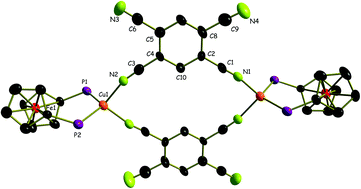
Dalton Trans., 2013,42, 16142-16150
https://doi.org/10.1039/C3DT51360B
Discrete and polymeric heteronuclear constructs derived from triangular 2,2′-bipyrazine complexes of cis-a2PtII (with a = NH3 or a2 = en)
Triangular, vase-shaped PtII complexes of 2,2′-bipyrazine are stitched together in multiple ways by heterometal ions (Cu2+, Cd2+, Ag+). Anion hosting properties of these constructs are pronounced.
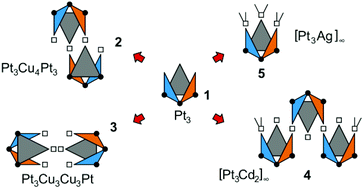
Dalton Trans., 2013,42, 16151-16161
https://doi.org/10.1039/C3DT51589C
Photovoltaic properties of TiO2 loaded with glutathione-protected silver clusters
Size-selected Ag clusters (Ag15, Ag25 and Ag29) loaded on TiO2 electrodes function as photosensitizers. Ag15 clusters yielded the internal quantum efficiency of 28% at 460 nm in the presence of [Co(bpy)3]2+.

Dalton Trans., 2013,42, 16162-16165
https://doi.org/10.1039/C3DT51648B
Cathodic photocurrent generation from zinc-substituted cytochrome b562 assemblies immobilized on an apocytochrome b562-modified gold electrode
Hierarchical assemblies of photoactive cytochrome b562 reconstituted with zinc protoporphyrin IX covalently linked with the protein surface were constructed on a gold electrode modified with an apoprotein of cytochrome b562.
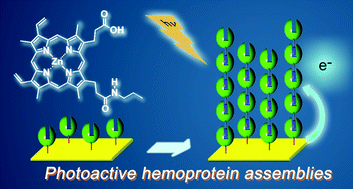
Dalton Trans., 2013,42, 16102-16107
https://doi.org/10.1039/C3DT51469B
Molecular rectangles from platinum(II) and bridging dicarbene, diisocyanide and 4,4′-bipyridine ligands
The tetranuclear molecular rectangle [18](BF4)8 featuring two different types of bridging di-NHC ligands has been obtained from a dinuclear dicarbene-bridged platinum(II) complex and β,β′-dihydroxyphenyl-1,4-diisocyanide followed by cleavage of the Si–O bonds of the isocyanide.

Dalton Trans., 2013,42, 16128-16141
https://doi.org/10.1039/C3DT51813B
Adsorption and detection of Escherichia coli using an Au substrate modified with a catecholate-type artificial siderophore –Fe3+ complex
A self-assembled monolayer of a catecholate-type artificial siderophore-Fe3+ complex was prepared and its adsorption and detection abilities for Escherichia coli was investigated.
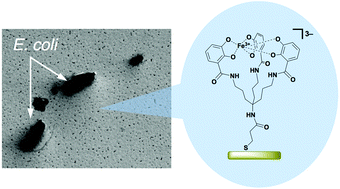
Dalton Trans., 2013,42, 16043-16048
https://doi.org/10.1039/C3DT51448J
Enhanced bimolecular exchange reaction through programmed coordination of a five-coordinate oxovanadium complex for efficient redox mediation in dye -sensitized solar cells
An oxovanadium(IV/V) couple gave rise to an efficient redox mediation in a DSSC to achieve photovoltaic conversion efficiency exceeding 5%.
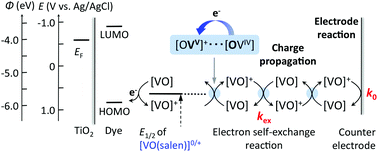
Dalton Trans., 2013,42, 16090-16095
https://doi.org/10.1039/C3DT51698A
Oxidant-induced intramolecular triazole formation
Coordination of Eu(III)- or Gd(III)-ions by C3-symmetric triaminoguanidinium based ligands leads to 1,2,4-triazole formation. Using Pd(II)-complexes as a model system, this triazole formation could be analyzed in detail using O2 or H2O2 as an oxidation reagent. The steric demand of the PR3-coligand seems to play a key role in the cyclization reaction.

Dalton Trans., 2013,42, 16066-16072
https://doi.org/10.1039/C3DT51490K
6-Substituted purines containing thienyl or furyl substituents as artificial nucleobases for metal-mediated base pairing
Purine derivatives with a furyl or thienyl substituent have been investigated in terms of their applicability in metal-mediated base pairs.
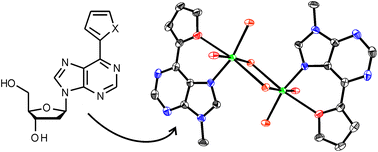
Dalton Trans., 2013,42, 16080-16089
https://doi.org/10.1039/C3DT51691A
Structure-distortion-induced photomagnetic effect in azobenzene /polyoxometalate Langmuir–Blodgett films
Reversible photoisomerization of azobenzene (AZ) led to a structure-distortion of a polyoxometalate (POM), resulting in the photomagnetic effect.
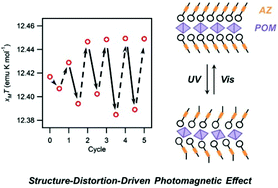
Dalton Trans., 2013,42, 16014-16020
https://doi.org/10.1039/C3DT51402A
Metal array fabrication based on ultrasound-induced self-assembly of metalated dipeptides
Pd- and Pt-bound bis-metalated peptides were synthesised by the condensation of Pd- or Pt-aldimine-complex-bound glutamic acids to afford the four possible metal isomers of bis-Pd and bis-Pt-homometalated dipeptides and PdPt- and PtPd-heterometalated dipeptides without metal disproportionation.
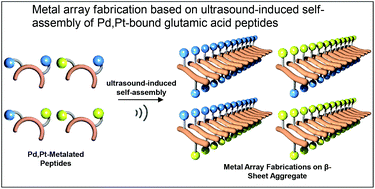
Dalton Trans., 2013,42, 15953-15966
https://doi.org/10.1039/C3DT51696B
Fluorescent colour modulation in Zn(II)-based metallo-supramolecular polymer films by electronic-state control of the ligand
Zn(II)-based metallo-supramolecular polymers showed different luminescent colours of blue, cyan, and green in the film state by ligand modification.

Dalton Trans., 2013,42, 16036-16042
https://doi.org/10.1039/C3DT51354H
Proton -exchange mechanism of specific Cs+ adsorption via lattice defect sites of Prussian blue filled with coordination and crystallization water molecules
Cs+ is trapped by chemical adsorption via the hydrophilic lattice defect sites through proton-elimination.
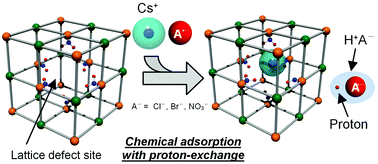
Dalton Trans., 2013,42, 16049-16055
https://doi.org/10.1039/C3DT51637G
Programmed multiple complexation for the creation of helical structures from acyclic phenol –bipyridine oligomer ligands
Phenol–bipyridine oligomer ligands were designed and synthesized so that the complexation with multiple metal ions leads to single helical complexes in a pre-programmed fashion.
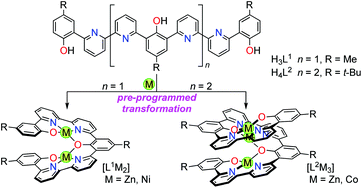
Dalton Trans., 2013,42, 15974-15986
https://doi.org/10.1039/C3DT51240A
Photonic gratings of the metal–organic framework {Fe(bpac)[Pt(CN)4]} with synergetic spin transition and host–guest properties
Optical diffraction, surface plasmon resonance spectroscopy and Raman micro-spectroscopy studies on surface-relief photonic gratings of {Fe(bpac)[Pt(CN)4]}.
![Graphical abstract: Photonic gratings of the metal–organic framework {Fe(bpac)[Pt(CN)4]} with synergetic spin transition and host–guest properties](/en/Image/Get?imageInfo.ImageType=GA&imageInfo.ImageIdentifier.ManuscriptID=C3DT51687C&imageInfo.ImageIdentifier.Year=2013)
Dalton Trans., 2013,42, 16021-16028
https://doi.org/10.1039/C3DT51687C
Programmed functionalization of SURMOFs via liquid phase heteroepitaxial growth and post-synthetic modification
This successful integration of two spatially separated MOFs into one heterostructured film resulted in size selectivity and high storage capacity.
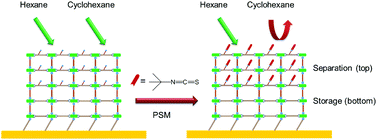
Dalton Trans., 2013,42, 16029-16035
https://doi.org/10.1039/C3DT51457A
Metallo-regulation of the bimolecular triplex formation of a peptide nucleic acid
PNA conjugates incorporating a bipyridine unit were prepared. The conjugate may be useful as an allosteric DNA carrier that releases the DNA in response to a certain metal ion concentration.
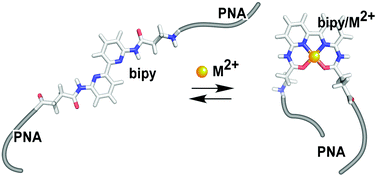
Dalton Trans., 2013,42, 16006-16013
https://doi.org/10.1039/C3DT51386F
Self-association and columnar liquid crystalline phase of cationic alkyl -substituted-bipyridine benzenedithiolato gold(III) complexes
The introduction of a Au(III) ion into the asymmetric mesogenic core leads to the formation of self-associating, cationic columnar structures in both the crystalline and rectangular columnar liquid crystalline state.

Dalton Trans., 2013,42, 15995-16005
https://doi.org/10.1039/C3DT51444G
Plasmon-induced oxidation of gold nanoparticles on TiO2 in the presence of ligands
Au nanoparticles are oxidized by plasmon-induced charge separation in the presence of SCN−, Br− or Cl−, chiefly via direct oxidation. The photopotential of Au is suggested to depend on both the flatband potential of TiO2 and the excitation wavelength.

Dalton Trans., 2013,42, 15937-15940
https://doi.org/10.1039/C3DT51495A
A liquid-crystalline perylene tetracarboxylic bisimide derivative bearing a triethylene oxide chain and complexation of the derivative with Li cations
Electron- and ion-transporting liquid-crystalline perylene tetracarboxylic bisimide was synthesized. This compound exhibits a lamellar mesophase and electron mobility exceeding 10−3 cm2 V−1 s−1 at room temperature.
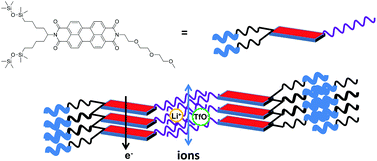
Dalton Trans., 2013,42, 15987-15994
https://doi.org/10.1039/C3DT51435H
Flexible, linear, tetranuclear palladium complexes supported by tetraphosphine ligands with electron-withdrawing groups
Linear tetranuclear palladium complexes were synthesized by using a new tetraphosphine with electron-withdrawing substituent groups.
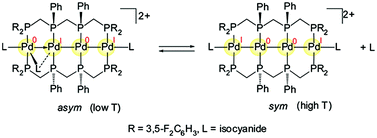
Dalton Trans., 2013,42, 15941-15952
https://doi.org/10.1039/C3DT51433A
Programming MOFs for water sorption : amino-functionalized MIL-125 and UiO-66 for heat transformation and heat storage applications
Reversible water adsorption/desorption renders hydrophilic Ti- and Zr-MOFs interesting candidates for sorption-based chilling or heat pump systems.
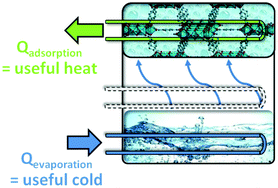
Dalton Trans., 2013,42, 15967-15973
https://doi.org/10.1039/C3DT51471D
Metal complexes in molecular junctions
The use of metal complexes to achieve a conductive molecular junction with a special focus on organometallics is overviewed and illustrated with representative examples. The prospects offered by such compounds owing to their specific properties are discussed.

Dalton Trans., 2013,42, 15859-15863
https://doi.org/10.1039/C3DT51487K
About this collection
Guest edited by Professors Hiroshi Nishihara and Hiroki Oshio, this themed issue highlights how coordination programming—the molecular design of coordination compounds—is essential for the construction of systems with targeted physical and chemical functionalities.